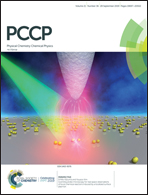Linking capacity loss and retention of nickel hexacyanoferrate to a two-site intercalation mechanism for aqueous Mg2+ and Ca2+ ions†
Abstract
Prussian blue analogues (PBAs) are promising cation intercalation materials for electrochemical desalination and energy storage applications. Here, we investigate the mechanism of capacity fade and degradation of nickel hexacyanoferrate (NiHCFe) during galvanostatic cycling in aqueous electrolytes that are rich in either Mg2+ or Ca2+. We combine experimental characterization, first principles electronic structure calculations, statistical mechanics and lattice-percolation modeling of electron transfer to elucidate the mechanisms responsible for the degradation of NiHCFe and its partial retention of capacity. Electrochemical characterization of porous NiHCFe electrodes suggests a two-site intercalation mechanism, while spectroscopy reveals the presence of Ni2+ and Fe(CN)63− ions in the electrolyte post cycling in Mg2+(aq). Using simple coprecipitation reactions, we show that Mg2+ and Ni2+ can coexist in the lattice framework, forming stable PBAs. Galvanostatic cycling of these PBAs shows that the presence of Mg2+ in the lattice framework results in the dissolution of Mg1.5FeIII(CN)6 in water during oxidation. We propose that Mg2+ can partially substitute Ni2+ ions in the lattice framework during galvanostatic cycling, displacing the substituted Ni2+ ions into interstitial sites. Based on differential capacitance analysis we show that Mg2+ intercalates into interstitial sites at ∼0.45 V vs. Ag/AgCl and it displaces Ni2+ in the lattice framework at ∼0.05 V vs. Ag/AgCl. Substitution of Ni2+ leads to Fe(CN)63− and Ni2+ ions being removed into the electrolyte during oxidation. Using first principles density functional theory (DFT) calculations combined with a statistical mechanics model, we verify the thermodynamic feasibility of the proposed reaction mechanism and predict the fraction of Ni2+ ions being substituted by Mg2+ during intercalation. Further, analysis of the electron density distribution and local density of states indicates that Mg2+ ions can act as insulating defects in the lattice framework that render certain Fe ions electrically inactive and likely contribute to capacity fade along with dissolution of Fe(CN)63−.



 Please wait while we load your content...
Please wait while we load your content...